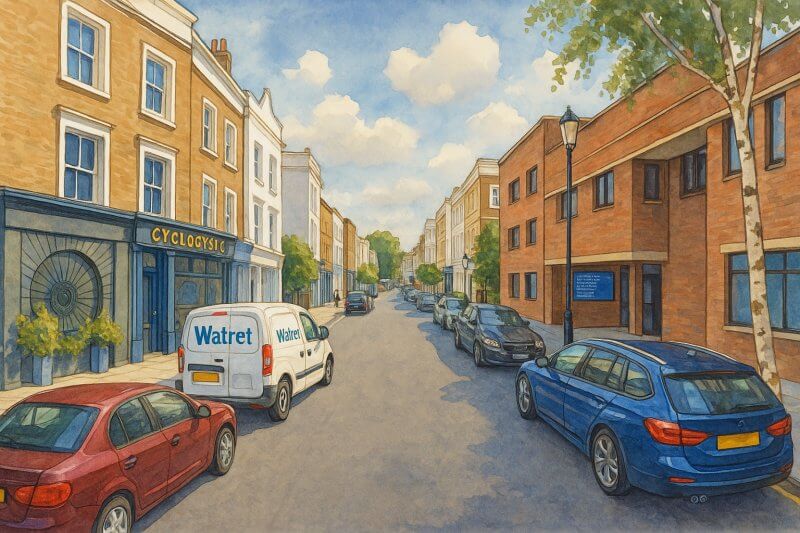
Notting Hill, London
Step Into One of London's Most Famous and Vibrant Areas
Notting Hill is one of London’s most beloved and recognisable neighbourhoods, famed for its pastel townhouses, bustling markets, and charming streets. Whether you know it from the famous film or from its world-renowned carnival, Notting Hill captures the imagination of visitors and locals alike.Where is Notting Hill? Understanding Its Location
Located in West London, Notting Hill falls within the Royal Borough of Kensington and Chelsea, bordering Westminster and touching parts of the Borough of Hammersmith and Fulham.On the map created for this page, you can see Notting Hill divided into two sections:
- North Section: Centred around Ladbroke Grove and the iconic Portobello Road Market area, this part is a lively hub full of shops, vintage stalls, and cafes.
- South Section: Closer to Kensington Park Road and Holland Park Avenue, this area is quieter and known for its elegant houses, leafy streets, and boutique shops.
The Size and Population of Notting Hill
Notting Hill covers an area of roughly 1.2 square miles (around 3 square kilometres).The estimated population is about 21,000 people. Despite its small size, the area’s density and cultural diversity create a vibrant, lively feel that resonates throughout the streets.
Map of Notting Hill, London
The Major Roads Forming Notting Hill
Several major roads define the layout and access points of Notting Hill:- Holland Park Avenue (part of the A40) runs east-west along the southern boundary.
- Ladbroke Grove cuts through the area vertically and serves as a central spine.
- Portobello Road winds through the heart of Notting Hill, forming the famous market route.
- Westbourne Grove is a significant shopping and dining street running across the area east to west.
The History of Notting Hill: From Rural to Renowned
Originally a rural area on the outskirts of London, Notting Hill remained mostly farmland until the early 19th century. It began to develop around the 1820s when landowner James Weller Ladbroke started creating a series of private communal gardens and elegant terraces.The name “Notting Hill” first appeared in written records in 1841. It is believed to derive from “Notting” or “Nutting,” possibly referring to the local trees or a Saxon-era settlement.
Throughout the Victorian era, Notting Hill underwent several changes, later becoming home to a diverse working-class population. In the 20th century, the area became famous for its Caribbean community, which played a key role in shaping its cultural identity.

Painting of Notting Hill (View full-size image here)
The Demographics of Notting Hill Today
Today, Notting Hill is a diverse and multicultural neighbourhood.Key demographic highlights include:
- Ethnic Diversity: Large communities of Afro-Caribbean, Portuguese, and Middle Eastern residents alongside long-standing British families.
- Age Range: A mix of young professionals, established families, and older residents.
- Income Levels: Generally affluent, though pockets of social housing remain, reflecting the area's complex social history.
Real Estate Prices: How Notting Hill Compares to the Rest of London
Notting Hill is one of London’s most expensive residential areas.As of early 2025, Notting Hill continues to be one of London's most sought-after and expensive neighbourhoods. The average property price in Notting Hill stands at approximately £1.24 million, reflecting a 4.3% increase over the past year and a 25.95% rise over the last five years .(Cash House Buyers)
The median sale price for properties in Notting Hill is around £1.44 million, with a median price per square foot of £1,473 . Rental prices are also notably high, with houses achieving a median monthly rent of £5,729, and apartments averaging £2,554 per month .(BHHS London)
These figures underscore Notting Hill's status as a prime residential area, attracting both domestic and international buyers seeking the unique blend of cultural vibrancy and architectural charm that the neighbourhood offers.
Important Buildings and Landmarks in Notting Hill
Notting Hill is home to many iconic buildings and landmarks:- Portobello Road Market: One of the world’s most famous street markets, open six days a week.
- The Electric Cinema: One of Britain’s oldest working cinemas, opened in 1910.
- St. John’s Church: A beautiful 19th-century church located on Lansdowne Crescent.
- Notting Hill Carnival: The streets themselves become landmarks during the Carnival, one of the world’s largest street festivals.
- The Blue Door: The famous door featured in the 1999 movie “Notting Hill,” located on Westbourne Park Road.
What Makes Notting Hill So Special?
The characteristics that define Notting Hill include:- Colourful Houses: Rows of pastel-painted townhouses give the area its whimsical, photogenic charm.
- Communal Gardens: Private gardens hidden behind rows of houses, many of which are historic and meticulously maintained.
- Independent Boutiques: A thriving scene of small shops, art galleries, and cafes, many of them independent and unique.
- Village Atmosphere: Despite being close to Central London, Notting Hill retains a laid-back, community-focused feel.
Nearest London Underground Stations and Lines
Several London Underground stations provide easy access to Notting Hill:- Notting Hill Gate: Served by the Central, Circle, and District lines.
- Westbourne Park: Served by the Hammersmith & City and Circle lines.
- Ladbroke Grove: Also served by the Hammersmith & City and Circle lines.
- Holland Park: Served by the Central line.
Fun Facts About Notting Hill
Notting Hill is full of quirky and fascinating trivia:- Largest Street Festival: The Notting Hill Carnival attracts over one million visitors every August Bank Holiday.
- Film Fame: The 1999 romantic comedy “Notting Hill,” starring Hugh Grant and Julia Roberts, catapulted the neighbourhood’s fame internationally.
- Bookshops Galore: The area boasts numerous independent bookshops, including the famous “Travel Bookshop” that inspired the film.
- Historic Communal Gardens: Many of the communal gardens date back over 150 years and were designed for the original Ladbroke Estate development.